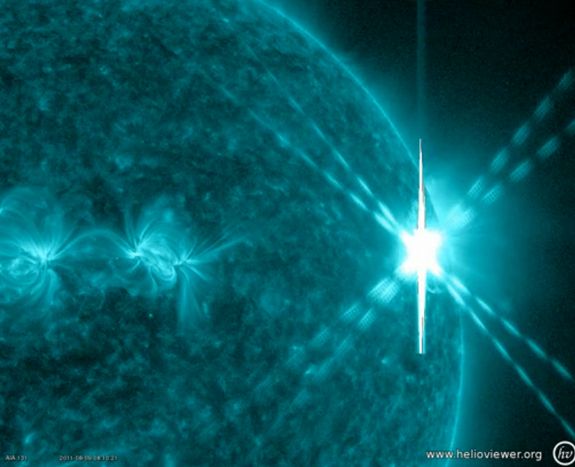NASA to Discuss Solar Storm Tracking Efforts Thursday

NASA will hold a press conference Thursday (Aug. 18) to discuss "new details about the structure of solar storms and the impact they have on Earth," space agency officials said in a statement.
The briefing this week will review new observations from several NASA spacecraft, including the Solar Terrestrial Relations Observatory (Stereo), that currently keep a close eye on the sun, agency officials said in the statement released today (Aug. 16). [Stunning Photos of Solar Flares & Sun Storms]
Thursday's briefing will be held at NASA's headquarters in Washington and will include presentations from several space weather experts. They include:
- Madhulika Guhathakurta, Stereo program scientist, NASA Headquarters
- Craig DeForest, staff scientist, Southwest Research Institute, Boulder, Colo.
- David Webb, research physicist, Institute for Scientific Research, Boston College
- Alysha Reinard, research scientist, National Oceanic and Atmospheric Administration and the University of Colorado, Boulder
The news briefing will begin at 2 p.m. EDT (1800 GMT) and will be broadcast live on the NASA TV cable channel, as well as webcast on the agency's NASA TV website.
The sun is currently in an active phase of its 11-year solar weather cycle (the current season is called Solar Cycle 24) and has erupted with several major flares in recent weeks. The solar cycle will peak in 2013, NASA scientists have said.
Last week, the sun unleashed its largest solar flare in more than four years. That Aug. 9 solar eruption registered as a class X6.9 sun storm on the three-tier scale used to measure the star's most powerful weather events. It caused some radio signal blackouts, but did not pose a serious threat to satellites and astronauts in orbit, or infrastructure systems on Earth as some major solar events can do. [Sun's Wrath: Worst Solar Storms in History]
Earlier this month, a series of three solar storms in three days sent a deluge of charged particles toward Earth that created dazzling aurora displays above the Earth's polar regions, known as the northern lights in the Northern Hemisphere and the southern lights in the south.
Sign up for the Live Science daily newsletter now
Get the world’s most fascinating discoveries delivered straight to your inbox.
NASA's Stereo mission is actually a pair of spacecraft keeping a constant watch on the sun from different positions. One Stereo probe is in an orbit that precedes the Earth while the other follows behind the planet. As their name suggests, the two spacecraft work together to provide a stereo look at the sun's weather.
Another NASA spacecraft, the Solar Dynamics Observatory, records high-definition video of the sun and beams it back to Earth. In addition, the joint NASA-European Solar Heliospheric Observatory, or SOHO, and other space-based solar observatories also keep watch on the sun.
This story was provided by SPACE.com, sister site to LiveScience. Follow SPACE.com for the latest in space science and exploration news on Twitter @Spacedotcom and on Facebook.













